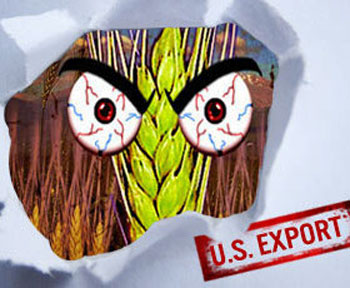|

by Aaron Dykes and Melissa Melton
June 30, 13
from
TruthstreamMedia Website
How did genetically
modified wheat
escape and taint the fields of
American farmers?
The unsettling case remains
unexplained,
but traces back to a
USDA seed vault.

According a recent article in the
Denver Post, the unapproved strain
of genetically modified (GM) wheat that tainted fields in Oregon and
prompted a lawsuit from farmers was, in fact, being stored in a
government seed bank in Fort Collins, Colorado.
This location is the National Center for Genetic Resources
Preservation (NGCRP),
operated by the USDA on the Colorado State University campus and
formerly known as the National Seed Storage Laboratory (NSSL).
It sits nearby the USDA’s Crop Research
Laboratory. The NGCRP serves a seed bank and,
“a repository for animal genetic
resources in the form of semen and plant genetic resources in
the form of graftable buds or in vitro plantlets.”
This facility began storing
Monsanto’s GM wheat strains
starting in 2004, but it claims to have destroyed them as of January
of 2012.
Did this USDA facility play a role in
the escape of unapproved GM wheat?
Ed Curlett, a spokesperson for the USDA, said,
“Whatever seed Monsanto sent to the
repository was incinerated.”
That agency’s claim is currently being
investigated for validation. But, where there’s smoke, there’s
typically fire.
Reuters
obtained documents indicating that the USDA’s National Center
for Genetic Resources Preservation took possession of,
“at least 43 physical containers of
Monsanto’s so-called ‘Roundup Ready’ wheat in late 2004 and
early 2005.”
This included ‘more than 1,000 different
unique varieties or lines’ of the GM wheat, which would
help to explain how the Oregon fields had been tainted with a
different variety than Monsanto was reportedly testing during its
field trials from 1997-2005 in at least 16 states.
Testing in Oregon, where the
tainted wheat was found, reportedly
ceased in 2001 and involved Spring wheat while unapproved
strains of GM Winter wheat were discovered.
According to Reuters, Monsanto also stored seeds from its GM wheat
varieties in St. Louis where the company’s headquarters is located.
Monsanto has expressed its theory that
an act of sabotage, and not inadvertent contamination, was behind
the Oregon wheat incident, while the USDA considers it “under active
investigation.”
As
we previously reported, it has come to light that Monsanto
actually
resumed testing of their GM wheat in 2011, currently growing
strains in test plots in both Hawaii and North Dakota.
According to Common Dreams:
Even if Monsanto’s claims about this
specific wheat strain were proven true, Monsanto has resumed
trials of other and very similar GM wheat seeds, according to
information posted in a U.S. Department of Agriculture (USDA)
database.
Monsanto planted 150 acres of GM
wheat in Hawaii last year and 300 acres of GM wheat in North
Dakota this year - meaning the risk of genetic pollution from
unapproved Monsanto wheat is even greater than most people are
aware.
While both Monsanto and U.S. authorities
maintain their belief that no food crops were contaminated in the
incident, it has shaken faith in the global wheat market, just as GM
watchdogs like the
Organic Consumers Association have long warned could threaten
the financial stability of U.S. wheat farmers.
This scandal has already triggered
rejections of imports from Japan and South Korea.
What is evident here, but not expressed or emphasized, is that the
government agencies who are supposed to be regulating biotech
companies from Monsanto on down are actually their biggest backers -
and it includes more than just regulatory approval.
Our recent and forthcoming investigations have revealed that biotech
is the frequent recipient of government grants as they develop new
strains of GMO crops, including pharmaceutical drug strains grown in
plants.
The National Institutes of Health (NIH)
issued an estimated $6.1 billion in grant money to biotechnology
research for FY2014, and similar numbers in previous years.
Grant money is further issued through
agencies like the
National Science Foundation and other branches of the
government, while
states like Iowa have created funds to bolster genetically
modified crop research, all giving aid to biotech companies
attempting to bring GM crops to market.
This makes the federal government a partner and investor in these
unproven crops, even as they are supposed to be functioning as
WATCHDOGS….
Unapproved Monsanto GMO Wheat Caught
Tainting an Oregon Field
Instead, Secretary of Agriculture Tom Vilsack is, in reality,
one of the biggest de facto lobbyists for genetically engineered
crops, having pushed legislation that protects GM crops, argued
against containment of open air experimental pharma crops, and even
set up the Iowa Values Fund, which has given biotech financial
incentives to plant in Iowa.
While governor in Iowa, Vilsack was even
named ‘Governor of the Year’ by the largest GMO lobbying group,
the Biotechnology Industry Organization.
Further assistance for private biotech corporations has come from
their partnerships with various seed research and storage facilities
which operate with the philanthropic and NGO arm to coordinate a
global agricultural policy.
The USDA’s National Center for Genetic Resources Preservation, like
its international counterparts Consultative Group on
International Agricultural Research -
CGIAR - (created by the
Rockefeller Foundation) and the
Global Crop Diversity Trust, under the UN’s Food and Agriculture
Organization and directed by the
Rockefeller Foundation-funded Friends of Global Crop
Diversity, Ltd., work to preserve farmer-derived and wild
varieties of plant and animal species, as well as “improved” (i.e.
GMO) varieties.
The major foundations, including the
Bill and Melinda
Gates Foundation (who
recently funded a wheat research facility in Mexico) and
the aforementioned Rockefeller Foundation are heavily involved in
this organizational structure, overlapping with their significant
agenda in controlling global agriculture and promoting the use of
genetically modified crops as a (dubious) solution to world hunger.
These centers, like the much-discussed arctic
“doomsday”
seed vaults, contain a “Noah’s Ark” genetic reservoir,
even as consequences from genetically modified agriculture - both
intended and unintended - threaten the viability of farmers and the
continuity of organic life on earth.
|

